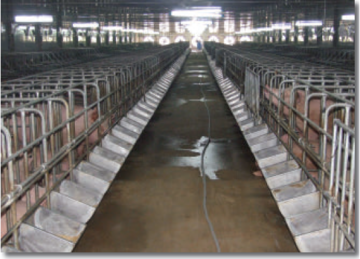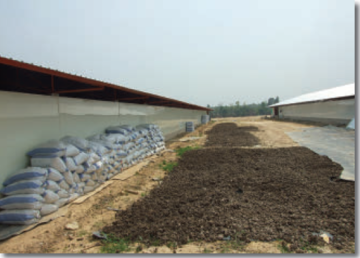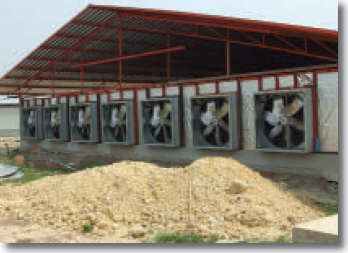.
--> Introduction
--> Traditional cooling methods
.
THAI PIG PRODUCER USES INSULATION TO HELP SOWS MAINTAIN COMFORT ZONE IN HIGH TEMPERATURES
By Stuart Lumb
.
INTRODUCTION
Thai pig producer Tanupat Sangkalits is using Styrofoam panels 25mm- and 50mm-thick as insulation to help his sows maintain their comfort zone in high temperatures.
Pigs perform best in their so-called comfort zone. The zone is bounded at the bottom by the Lower Critical Temperature, when pigs burn feed to keep warm, and at the top by the Upper Critical Temperature, when they become heat stressed, eat less and lose performance.
In Thailand, the temperature is roughly between 20 degrees C and 36 degrees C, with high humidity. While Thai piggeries may need some heating, their greatest concern is keeping pigs cool.
Image 1 Thai pig producer and engineering specialist, Tanupat Sangkalits, adjusts the computer controls for his new pig sheds
^ Top page
.
TRADITIONAL COOLING METHODS
The high temperatures naturally affect feed intake and sow growth rates. Older piggeries in Thailand tend to have high roofs and are open-sided with natural ventilation often aided by large fans suspended from the roof. Even so, temperatures can vary by as much as 10 degrees C between the morning and the night. One way to control temperature changes is to install blinds that can be raised and lowered depending on the temperature on the sides of sheds.
Tunnel ventilation is used instead of open-sided buildings with blinds to reduce temperatures, with huge banks of fans located at one end of the building. These pull air that has been has cooled after being drawn through water-cooled pads at the other end, or through side inlets, through the building.
Naturally, electricity consumed by these fans is an ongoing, but essential cost as pigs will not perform if they are heat stressed.
^ Top page
.
ENERGY-EFFICIENT COOLING
Sangkalits recently invested USD $833,333 in his 1,600-sow business on a 40-acre site in Prachinburi province in the east of Thailand. The unit has three gestation sheds containing 400 stalls in each, plus three farrowing sheds, each of which is divided into two rooms with 66 crates.
Rather than fit blinds down the sides of the barns, Sangkalits decided to line the sides and roof of his sheds with insulated panels. Outside daily temperatures can range from 35 degrees C to 40 degrees C, but the panels help to keep the inside temperature around 28 degrees C with relative humidity at 90%. All the houses are lined with these panels. The roofs have 25mm-thick panels acting as a false ceiling and 50mm panels are used to form the actual walls of each shed.
Image 2 A sow stall house lined with Styrofoam panels
Image 3 Sow sheds fitted with panels, and between them manure is dried for fertilizer
Reducing the internal temperature in the sheds should help lactating sows and gilts eat more and boost productivity, but time will tell. The first batch of 66 gilts reared an average of 10 piglets per litter at a weight of 7.2kg at three weeks of age, which bode well for the future. The sheds all feature a conventional tunnel ventilation system, with the smooth, flat nature of the panels helping airflow as it is pulled through the houses by large fans mounted at one end. The incoming air is cooled by being drawn through pads that are kept constantly moist with water dripping on them through gravity.
Image 4 A row of fans at one end of the new building draws cool air to keep temperatures low for the pigs inside
Sangkalits has fitted inverters as part of the ventilation system and these make the fans run more efficiently to reduce electricity usage. If the ventilation system malfunctions outside normal working hours, an alarm is sent via text message to his staff.
^ Top page
.
JUST-IN-TIME CONSTRUCTION
The whole unit was built on a just-in-time basis, so that the farrowing pens were completed just a few days before the gilts were due to farrow. This way of building is risky, but helps the cash flow considerably, as does the fact that Sangkalits’s staff constructed farrowing crates on site. All the farrowing pens are raised off the solid floor, which is a cheaper option than digging out slurry channels and installing the crates at floor level. The floor is swilled down twice daily to remove manure.
In hot Asian countries, a good water supply is vital. Generally, bore holes are drilled to tap the aquifer, but this can be quite expensive. Sangkalits is lucky that his farm has a high water table and his water is found only four metres down. A 20-metre lagoon has been excavated, containing water which rises to a height of 16m. None of the site water is wasted, as all the roof water is channelled into the lagoon.
As a Thai Foods Group contracted producer, Sangkalits buys all his pig feed from the group which in return buys back all his piglets at USD $16.6 (Thai baht 500) for the first 4.5kg and USD $7.3 for each additional kg after that. His first batch of 660 piglets averaged USD $36.4, which he found very encouraging. Given good productivity along with the unit’s ingenious insulation-driven design features, Sangkalits is confident that his investment will be paid off within five years.
This article appeared in Pig International, November/December 2011. ©Copyright 2012, All Rights Reserved.
.
Related topics: temperature cooling building information swine sow

 Corporate Website
Corporate Website
 Africa
Africa
 Argentina
Argentina
 Asia
Asia
 Australia
Australia
 Belgium
Belgium
 Brazil
Brazil
 Bulgaria
Bulgaria
 Canada (EN)
Canada (EN)
 Chile
Chile
 China
China
 Colombia
Colombia
 Denmark
Denmark
 Egypt
Egypt
 France
France
 Germany
Germany
 Greece
Greece
 Hungary
Hungary
 Indonesia
Indonesia
 Italia
Italia
 India
India
 Japan
Japan
 Korea
Korea
 Malaysia
Malaysia
 Mexico
Mexico
 Middle East
Middle East
 Netherlands
Netherlands
 Peru
Peru
 Philippines
Philippines
 Poland
Poland
 Portugal
Portugal
 Romania
Romania
 Russia
Russia
 South Africa
South Africa
 Spain
Spain
 Sweden
Sweden
 Thailand
Thailand
 Tunisia
Tunisia
 Turkey
Turkey
 Ukraine
Ukraine
 United Kingdom
United Kingdom
 USA
USA
 Vietnam
Vietnam







